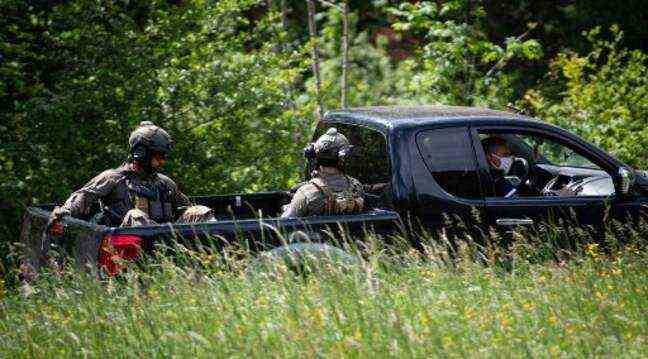GIGN snipers sitting in the back of a pickup during the hunt for Valentin Marconne, near the village of Plantiers, in the Cévennes, on May 12. – CLEMENT MAHOUDEAU / AFP
- Valentin M. is suspected of having shot his boss and one of his colleagues in the sawmill where he was employed, last Tuesday in Plantiers (Gard). Since then, he has fled into the Cévennes forest and remains, this Friday again, untraceable, despite the significant research resources deployed.
- Two elements complicate the research, points out Guillaume Farde. The area in which Valentin Marcone is sought is made up of 15 km² of forests that are very difficult to access. The profile of the fugitive, then, probably armed, so that the operation is at high risk for the gendarmes.
- “We are not looking for a lost person, but a man suspected of having already killed two men,” said Guillaume Farde.
The calls of the public prosecutor of Nîmes and of his father to surrender did not change anything. Still no trace of Valentin M .. The 29-year-old man, suspected of having shot his boss and one of his co-workers in a sawmill in the village of Plantiers (Gard), has been on the run since Tuesday morning. The gendarmerie, which took out the big means – 350 mobilized gendarmes, eight helicopters, drones, dog teams -, searches for him within a perimeter of 15 km². But without success to date. Astonishing? Not that much, explains Guillaume Farde, professor affiliated with Sciences Po, specialist in security issues. He responds to 20 minutes.
Could we expect Valentin M.’s run to last so long?
It was quite possible, yes, and at no time did the national gendarmerie commit to the slightest delay for the arrest. It is absolutely impossible. From the moment the criminal acts are committed, the suspect has a head start. Valentin M. returns home, he gathers equipment, ammunition and weapons, then flees into a forest he knows very well.
The first action of the gendarmerie, very classic in this type of search operation, is to establish a search zone. Valentin M. being, in all likelihood, left on foot, the gendarmeries established this perimeter according to the distance that a man can cover on average. This gives this quadrilateral of about fifteen km². It remains a large perimeter, and searches are all the more difficult inside as this land is difficult to access. It is very hilly, wooded, crossed by rivers, etc.
What is in favor of Valentin M. in the face of the 350 gendarmes deployed, the eight helicopters, the drones, the Saint-Bernard dogs?
The ground is already playing in its favor. There are necessarily multiple hiding places and we know, according to the information given by the public prosecutor on the profile of Valentin M., that he knows the place very well. This forest is in the immediate vicinity of his home, he is a hunter and able to survive in a hostile environment.
And then, it is not a “classic” search operation. We are not looking for a lost person, but a man suspected of having already killed two men and whose profile, as it has been identified by GIGN psychologists, is that of a very paranoid person, trained in shooting. He is likely to have weapons at his disposal, including a precision rifle. In other words, we cannot rule out the hypothesis that Valentin M. is ambushed somewhere in this perimeter of 15 km².
It is, therefore, a high-risk search operation for the gendarmes. They have to move carefully and it takes time. It is undeniable that this man will be found alive or committed suicide but, if he is alive, we do not know if he will want to surrender or confront the gendarmes.
How is the search for such a fugitive going?
The first thing is to identify the psychological profile of the fugitive and to determine the perimeter of the search. Then we come to the actual research. There are gendarmes specialized for this type of search operation, trained to advance even under fire and who can use many technical means. For Valentin M., we are talking about 350 deployed gendarmes, eight helicopters, Saint-Bernard dogs, night vision devices, etc.
This may sound like a lot, but you have to take into account, once again, the complexity of the terrain. There are most certainly a number of characteristic points that have been identified within the research area – caves, caches, etc. – for which there must be clearances of doubts. In short: check if there is or not. And, even with significant technical resources, this work takes time.
We can not rule out the hypothesis that Valentin M. committed suicide. If this is the case, and if he committed suicide in a place that is difficult to access, the search operations could still take a long time, since once dead, your body loses its olfactory properties, which does not facilitate not research by dogs.
To concealment and suicide is added a third hypothesis which would be that Valentin M. would have managed to leave the perimeter of 15 km² in which the research is concentrated. Is it probable in your eyes?
It is a possible hypothesis, yes, and which has always been considered by the gendarmes themselves. But it is considered less likely because, once again, Valentin M. left on foot and the distance that can be covered in a given time remains limited. And, like any human being, he also needs to sleep, rest, eat … We define a research perimeter based on all this data and this is what resulted, in the specific case of Valentin M., to this quadrilateral of 15 km².

